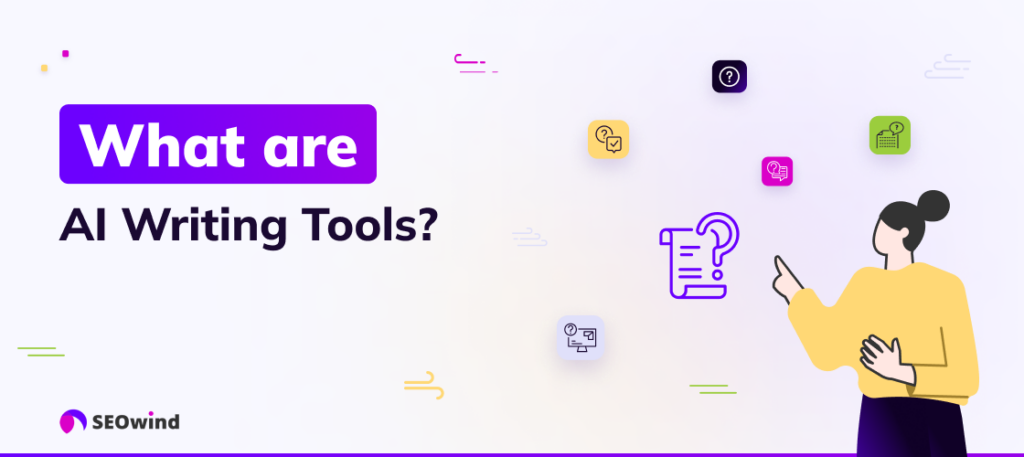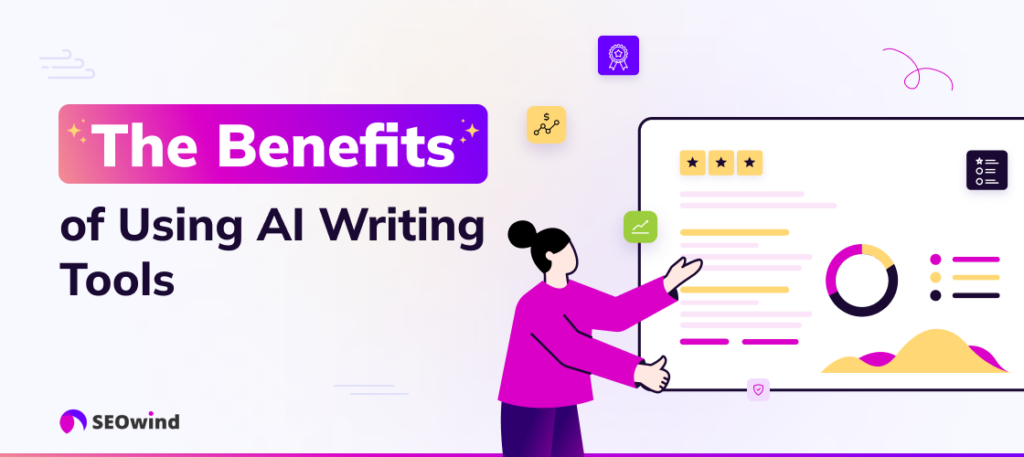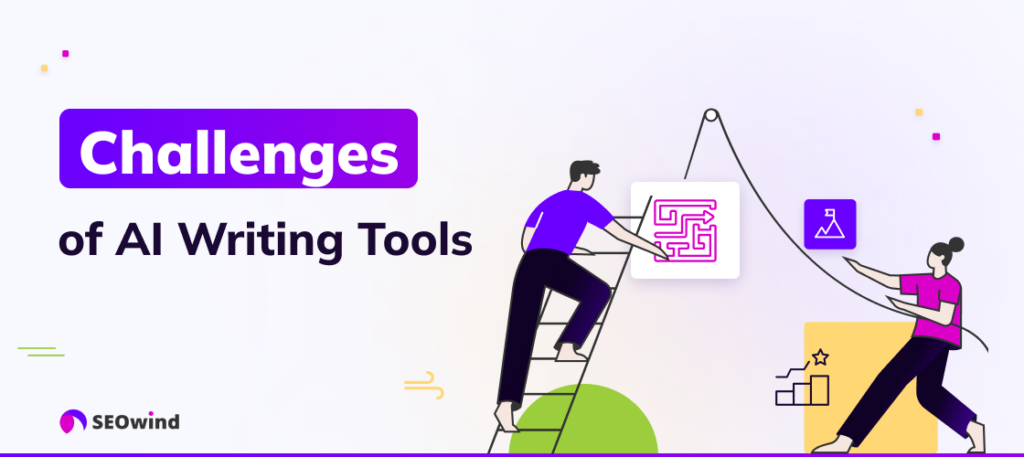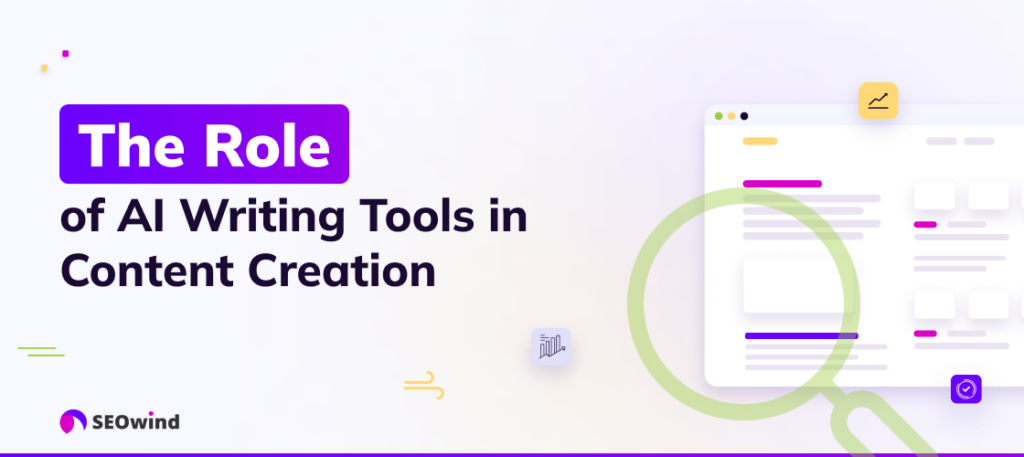A new type of assistant is emerging to help writers craft their work more effectively: Artificial Intelligence writing tools. But why should you consider integrating such technology into your workflow? And what are the potential pitfalls that await? This comprehensive guide will walk you through all there is to know about AI writing tools, examining their benefits, challenges, and future role in content creation. Ready for an enlightening journey?
Without further ado, let’s start by defining what exactly AI writing tools are.
Explanation of What AI Writing Tools Are

Artificial intelligence (AI) writing tools leverage advanced algorithms to facilitate or even automate various aspects of the writing process. These intelligent assistants don’t write in the traditional human sense. Instead, they use machine learning techniques to analyze vast amounts of data, understand patterns in text, and then generate relevant content based on those patterns.
But how do these tools make such potential into reality? Stay tuned as we dive deeper into the operational dynamics of AI writing tools in our next section.
How AI Writing Tools Work
Before we discuss the potential benefits and drawbacks of using AI writing tools, let’s first explore how these ingenious digital assistants function.
Artificial Intelligence (AI) writing tools are software programs powered by advanced machine learning algorithms. These highly sophisticated technologies can learn from patterns, manage complex datasets, and make elaborate predictions based on provided data.
The baseline mechanism behind any AI writing tool typically comprises two broad phases: training and generation.
In the training phase, these technologies ingest large volumes of text data, typically drawn from online sources such as blogs, articles, academic papers, or books. They analyze sentence structure, grammar usage, vocabularies, and even subtler nuances like stylistic elements and tone of the text.
Then comes the generation process, at which point the Artificial Intelligence creates new content. Provided with a prompt or keyword by a user, an AI writing tool retrieves its learned language patterns to construct appropriate sentences that align with the given context.
Intriguingly, these writing assistants don’t just use stored information. Instead, they utilize statistical models to predict likely sentence sequences, forming meaningful content in alignment with your chosen theme or topic.
Yet another fascinating component is Natural Language Processing (NLP). NLP allows AI to understand, interpret, and produce human language in a much more realistic manner. Metaphorically speaking, if content creation was akin to cooking, then NLP serves as the essential seasoning that uplifts the overall flavor of an otherwise bland dish!
Despite all this automation, it’s crucial to remember leveraging AI writing tools effectively often requires some degree of human touch. However, we will look closer at that subject later.
In essence, AI writing tools are technologically advanced companions designed to simplify the writing process by learning linguistic conventions and using them in an innovative way. While they aren’t perfect, their ability to swiftly generate content has already started revolutionizing professional writing.
AI Writing Tools Types and Capabilities
These applications vary greatly. Some help with simple tasks like grammar checks or identifying synonyms for word optimization, while others feature complex capabilities like producing full-length articles or blog posts using only a handful of instructions as input.
Fundamentally, each AI writer has one common goal: to streamline your creative process by offering a powerful combination of functionality, flexibility, and efficiency that surpasses what humans can traditionally achieve alone. It’s like having a tireless virtual companion ready on demand to assist with everything from research to drafting. As a result, you save ample energy that can be focused on injecting creativity into your masterpiece.
Brief History of AI Writing Tools
The history of Artificial Intelligence (AI) stretches back to the middle of the last century. However, the story of AI writing tools is considerably more recent, with significant progress made over the past few decades.
The Origins of AI
Let’s start by turning the clock back to 1950 when renowned computer scientist Alan Turing posed a fascinating question: “Can machines think?” This query laid out the path for AI research, which would later influence fields like AI writing.
Early AI Milestones
Fast-forward to 1996, when we witnessed an early application of AI in chess. IBM’s Deep Blue became infamous for defeating world champion Garry Kasparov, showcasing AI’s ability to ‘think’ and strategize decisively.
But you might still be wondering how this is related to AI writing. The answer is simple: those achievements were all about pattern recognition and prediction abilities, the keystones upon which modern-day language-processing AIs are based.
The Rise of Machine Translation
A noteworthy milestone belongs to Google Translate, launched in 2006. Although initial translations were often awkwardly phrased or misleading due to a word-for-word approach, continuous improvements introduced machine learning algorithms that recognize context, resulting in more natural-sounding translations.
Natural Language Processing Breakthrough
2015 heralded the emergence of a transformative technology: Natural Language Processing (NLP). NLP enabled computers to understand human language beyond mere data input, paving the way for contextual understanding across multiple languages and dialects.
The Birth of AI Writing Assistants
With the capacity for pattern recognition and predictive analysis combined with powerful computational capabilities and robust databases, intelligent writing assistants started taking shape as viable tools around 2016. These platforms exhibited proficiency in generating business copy such as reports, emails, and articles, indicating they also provided value as creators and shaping a promising future for automated long-form content generation.
Modern AI Writing Tools
Today’s popular AI-powered writing tools like Grammarly or OpenAI’s GPT boast incredible capacities beyond grammar review, like generating engaging content or providing stylistic suggestions. While OpenAI recently made headlines for its human-like writing capabilities, this technology continuously evolves and offers a fascinating road ahead.
The history of AI writing tools carries a variety of small discoveries that led to giant leaps in technological development. They exemplify how machines have progressively approximated and simulated human cognition and creative ability, an exciting narrative that continues to unfold. As we continue to develop AI technology, it’s necessary to consider its potential benefits and how it may revolutionize our interaction with the written word.
The Benefits of Using AI Writing Tools

There is no denying the transformative power that Artificial Intelligence offers in various sectors. It’s fascinating to consider how we might harness this technology to aid everyday tasks, including writing. Why should one use an AI writing tool? That’s a question you’ve probably asked yourself once or twice. Let us dive into some of the compelling benefits.
Increased Productivity and Efficiency
First and foremost, using AI to write significantly boosts productivity as it takes care of mundane elements associated with content creation. Instead of spending excessive hours on research, brainstorming, and arranging thoughts coherently, AI tools lessen these burdens by offering instant drafts that you can easily refine.
Consequently, efficiency is achieved as your energy gets channeled towards crucial areas such as editing and perfecting content structure. This frees up valuable time for other essential activities related to your business, leading to enhanced productivity overall.
AI can create content much faster than people, producing an article in minutes compared to the longer time it takes a human writer. This efficiency can significantly boost productivity, especially for businesses that require a high volume of content.
Improved Writing Quality
AI Writing tools come equipped with advanced features that can substantially elevate writing quality. These automated platforms have grammar correction capabilities, ensuring human errors are caught instantly before publishing the final draft. They also propose sentence restructuring to improve readability. All of this aims to produce more polished and professional content.
Enhanced SEO Optimization
If content isn’t optimized for search engines like Google, there’s little chance it will be found among billions of similar pages online. Thankfully, several AI writing tools come with SEO optimization features that assess keyword usage and density while keeping abreast of changing algorithms, enabling your pieces to rank higher in search engine results.
Boosted Creativity and Innovation
Enhancing Creativity and Innovation: Contrary to the fear that AI might stifle creativity, these tools can actually bolster it. AI writing tools can suggest new angles, diverse sentence structures, and unique word choices, sparking innovative ideas. Writers can use AI-generated content as a springboard, pushing the boundaries of their creativity and producing more engaging and original pieces.
Cost Savings and Scalability
Investing in an AI writing tool makes a lot of financial sense when you consider the long-term implications. Instead of hiring multiple content writers to tackle growing workloads, these automated programs promise scalability with no added recruitment costs. This makes AI the go-to choice for budget-conscious enterprises looking to maintain high-quality output without breaking the bank.
AI writing tools can produce a significant amount of content at a lower cost, with some tools charging a monthly subscription rate of around $100 for tens of thousands of words. This cost-effectiveness can be particularly beneficial for small businesses and startups with limited budgets.
Personalized Content and Targeting
Lastly, personalization is king in modern marketing. This is especially so in the digital space, which is dominated by tailored user experiences. AI writing tools tap into historical customer data, effectively generating persuasive copy that speaks directly to various consumer groups while resonating with their unique preferences. In this way, these platforms become instrumental allies in crafting personalized messages across different platforms, significantly enhancing prospect targeting and conversion rates.
Challenges and Drawbacks of AI Writing Tools

While we marveled at the benefits and numerous possibilities of AI writing tools earlier, it’s crucial to highlight their limitations, too. I’d be lying if I promised a picturesque journey without any bumps when using AI to write. So, let’s dig into these challenges together.
Concerns about Reliability
First, we must ask ourselves, “How reliable are these AI writing tools?” Despite advancements in technology, they’re not immune to errors. Erratic punctuation, improper grammar, and context-specific language subtleties often escape AI.
Besides that, AI-generated content can lack stylistic and tonal consistency because the tools generally learn from patterns and predictions rather than acquiring a human-like understanding of the text nuances. Consequently, depending solely on an AI for your writing needs can occasionally lead to unintended or awkward phrasing.
Issues Related to Relatability and Human Emotion
One major drawback of AI is its struggle to evoke emotional responses or empathy from readers. Authenticity is essential to good storytelling. It inspires smiles, tears, and excitement from anyone engrossed in the narrative. However well-programmed our digital pals might be, they still fall short in this area.
AI usually cannot understand the sentiment-bound intricacies that drive human emotions; as a result, they don’t pick up humor and sarcasm, thus jeopardizing relatability.
Humans have nuanced ways of expressing themselves under different circumstances, something Artificial Intelligence finds hard to replicate convincingly at this point.
Risks of Plagiarism and Copyright Infringement
Another obstacle you could encounter while using AI to write is potential plagiarism and copyright infringement risks.
AI tools generate content based on ingested data sources. This raises critical concerns about whether it’s a creative output or mere paraphrasing. While this might be fine for tasks like report generation, creative writing and content creation may prove more sensitive to such issues because originality takes precedence.
While tools exist for checking plagiarism, they mainly review text similarity rather than the uniqueness of ideas. Therefore, some instances of intellectual property theft can go unnoticed while using AI writing tools.
Potential Impact on Human Writers and the Job Market
The rise of AI writing tools has sparked concerns about their impact on human writers and the job market:
- Shift in skill requirements: Writers may need to adapt and learn how to effectively use AI tools.
- Focus on higher-level tasks: Human writers might shift towards more strategic and creative roles.
- Increased demand for editors: As AI generates more content, the need for skilled editors may grow.
- Specialization: Writers may need to specialize in areas where human expertise is still crucial.
While AI writing tools can significantly boost productivity, it’s crucial to maintain a balance between efficiency and authenticity. Over-reliance on AI-generated content may lead to a loss of brand voice and personal touch. Writers should use AI as a starting point, then infuse their unique perspective and expertise to create truly compelling content.
The Role of AI Writing Tools in Content Creation

AI writing tools are becoming increasingly important in content creation. Leveraging machine learning and natural language processing algorithms, these software solutions aid writers, marketers, and individuals seeking to produce well-rounded, high-quality materials without having to dedicate extensive hours laboring over keyboards and screens.
Assisting with Brainstorming and Idea Generation
So, why should you use an AI writing tool for brainstorming? One of the primary advantages of AI writing tools is their capability to stimulate creativity by generating fresh ideas for blog topics, article leads, or marketing slogans. Not unlike a literal brainstorm, these automated companions can take a singular thought and explode it into a galaxy of possibilities.
AI can turn a single keyword into an entire campaign narrative by basing suggestions on trending themes, search patterns, or predicted customer behavior. When you’re creatively drained or constrained by time pressures, AI’s idea-generation feature could be just the spark you need!
Overcoming Writer’s Block
One of the most challenging aspects of writing is overcoming writer’s block. AI writing tools can serve as a powerful ally in this regard by providing prompts, suggestions, and even generating initial drafts based on keywords or themes. This can spark creativity and help writers get past the initial hurdle of staring at a blank page.
Recommendation: For writers struggling with writer’s block, AI writing tools offer a lifeline by generating ideas and initial drafts. This jumpstart can transform a daunting task into a more manageable and even enjoyable process.
Accelerating Pre-Draft Research Process
In addition to ideation, using AI to write can save you countless hours wading through Google searches or sifting through source documents for research purposes.
Imagine you’re given an unfamiliar topic with few resources at hand. Instead of spending painful amounts of time gathering information manually, you can simply input your desired topic into your trusty AI tool. In minutes (if not seconds), it delivers concise summaries from relevant sources and citations ready for inclusion in your draft.
This offers creators more freedom to toggle between tasks while ensuring they stay up-to-date with current trends and facts.
Finding Information Quickly For Content Creation Purposes
An automated helper also dramatically accelerates data retrieval.
Regardless of whether you’re hunting down statistics about smartphone usage among teenagers or seeking the newest studies about the effects of climate change on coffee plantations, AI can fetch it in an instant. It will also cherry-pick the most trusted publications and deliver condensed core information immediately.
You can fast-track content creation by drastically reducing the time spent on info-fishing.
Generating Ready-Made Templates for Various Types of Content
What is AI writing if not a fantastic tool for producing ready-made templates on demand? Whether you need an engaging introduction for a blog post, a professional email response, or relevant metadata for SEO, AI software has got you covered.
Pre-configured templates tailored to specific forms of content enable users to plug in the necessary data before receiving a complete piece ready to be posted.
No more staring blankly at the dreaded white screen, hoping inspiration strikes. Simply fill in the blanks and let your digital helper do the rest!
Implementing AI writing tools in one’s content creation routine provides significant benefits that go beyond word generation. These applications serve as versatile assistants, powering idea brainstorming sessions, accelerating research timelines, and sourcing required data swiftly while generating user-friendly content templates when needed. Despite this machine-generated brilliance, remember these tools should act as supplements rather than replacements. Ultimately, some tasks are best left in human hands.
Drawing the Line Between AI-Generated Content and Human Touch
The Importance of Human Editing and Proofreading in AI-Generated Content
When exploring why you should use an AI writing tool, do not underestimate the human touch. Remember that even these technological marvels work best when supervised by their human counterparts: writers, editors, and proofreaders.
AI writing tools learn from data they’ve been trained on, and there’s always a slim chance of errors slipping through. They might also miss nuances or create content that alienates rather than engages your audience.
For instance, misrepresenting the tone or creating content burdened by factual inaccuracies can spell disaster for your brand’s image. Even seemingly innocuous typos can have severe reputational consequences.
Having a pair of skillful human eyes scan through and edit AI-generated content is essential. Doing so turns good work into excellent work. At the end of the day, perfection lies in co-existence. We should aim to let AI do what it does best—streamline efficiency—and humans do what they do best—add personal charm.
Balancing the Use of AI and Maintaining a Specific Voice and Tone
Voice and tone make our content unique and enable it to stand out within an ocean of similar information.
While AI systems are progressively improving at mimicking style, they still cannot cultivate a genuinely distinct voice or tone for your brand. And trust me, this is a quality that resonates with your audience on a deeper level.
Therefore, as tempting as relying completely on an AI writing tool may sound, given its benefits, we need balance! Remember, people connect with people. A humorous quip here or heartfelt story there could set just the right mood for your readers while driving your point home!
By blending AI and human writing, you can leverage machine efficiency with genuine emotion to create a strong brand presence that speaks to your audience. Authentically human expressions have the power to touch hearts and minds—a subtlety machines cannot manage yet.
So, should you use an AI writing tool? Absolutely! But remember to sprinkle your individuality to make just the right impact!
The Future of AI in Content Creation

Let’s observe the present-day uses and shed light on future possibilities.
Predictions on How AI Will Redefine Content Creation Processes
An undeniable reality is that AI writing tools are already adept at generating grammatically correct, clear-cut copy based on defined parameters. Yet as advancements occur, as they certainly will, it’s plausible that AI will produce more nuanced material with flair and panache.
- Automated persona research: The days of massive audience persona spreadsheets may soon be behind us as advanced algorithms will predictively analyze what kind of content a specific target group prefers.
- Smarter semantic analysis: Rather than merely sticking to keywords or phrases, AI-based platforms may enhance their understanding of context, more competently deciphering the intricate semantics entwined in languages.
- Revolutionized content distribution strategy: Smart algorithms will unerringly pinpoint when and where to launch content for optimal results.
It’s not too far-fetched to anticipate that Artificial Intelligence could massively disrupt traditional content creation trajectories.
Potential Advancements in AI Technology for Writing Tools
I see the following potential direction in which AI writing tools can develop:
- A higher emotional quotient: We might develop more intelligent bots capable of accurately intuiting human emotions, thus effectively capturing moods in their creative output.
- Augmented capabilities to generate multimedia content: Think auto-generated infographics or explainer videos based on textual input!
- Interactive bots: More advanced tools could conduct real-time editing, offering context-aware suggestions and facilitating team collaboration.
In a sneak peek into the future, AI might sprout from its nascent stage, in which it merely assists us, to become sturdy allies that weave magic with words. However, caution must be exercised to ensure checks and balances are in place not to compromise originality or infringe on copyrights.
While transitional phases often prompt unease, the potential perks render it worth exploring. Always remember that AI tools don’t replace humans. Instead, they augment our abilities, freeing up time for strategizing, innovating, and polishing that which machines (as yet) cannot master: the human touch.
As we’ve traversed the landscape of AI writing tools, one question remains: should you use an AI writing tool? You need to answer for yourself.
I believe, this is the way.


